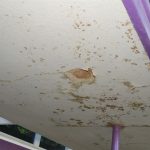Your home’s wooden floors exude timeless beauty and elegance, adding a touch of luxury to any space. However, water damage can quickly transform this beauty into a nightmare. Whether it’s from a burst pipe, a leaky roof, or an unnoticed spill, water can wreak havoc on your hardwood floors. Addressing water damage promptly and effectively is crucial to preserving the integrity and aesthetics of your cherished flooring. In this blog, we will understand how much time it takes for water to wreak havoc, explore the signs of water damaged floor and provide steps to fix your water-damaged swollen wood floor and regain its original grace and charm.
How Long Does It Take for Water To Damage Wood Floors?
The time it takes for water to damage wood floors can vary based on several factors, including the amount of water, the type of wood, and the humidity levels. However, it’s essential to understand that even a short period of exposure to water can initiate the damage process.
- Immediate Impact: Upon contact with water, wood floors start absorbing moisture. Within the first few hours, the wood may swell and warp, leading to visible changes in the flooring’s appearance.
- 24-48 Hours: If water exposure continues for a day or two, the moisture absorption worsens, causing further warping, cupping, or crowning. Discoloration and staining become more pronounced during this time.
- 72 Hours and Beyond: Beyond 72 hours, the damage becomes increasingly severe. Mold and mildew growth accelerate, posing health risks and potentially requiring extensive restoration or replacement of the affected wood.
Signs of Water Damage on Wooden Floor:
Detecting water damage early is crucial to prevent further deterioration and minimize repair costs. Here are some noticeable signs that your wooden floor may be suffering from water damage:
- Swelling: Wood tends to absorb water, causing it to swell and distort its shape. This often leads to an uneven or bumpy surface.
- Warped or Buckled Boards: Excessive moisture can cause the wooden boards to warp, buckle, or cup, disrupting the smooth surface of the floor.
- Discoloration: Water exposure can stain the wood, leaving unsightly dark spots or patches that mar the floor’s appearance.
- Mold and Mildew Growth: Moisture-laden wood is a breeding ground for mold and mildew, resulting in a musty odor and potential health hazards.
- Spongy Feel: When walking on the floor, if it feels soft or spongy underfoot, it’s a clear indication of water damage.
If you find yourself facing a swollen wood floor due to water damage, the question of whether it can be fixed is likely at the forefront of your mind. The good news is that in many cases, a swollen wood floor can indeed be restored. Through diligent assessment, timely action, and appropriate restoration steps like drying, sanding, refinishing, and potential board replacement, you can often bring your wood flooring back to its former glory. The key lies in prompt and thorough intervention to mitigate damage and preserve the natural beauty of your wooden floor.
8 Effective Steps For Fixing Water-Damaged Swollen Wood Floors
Here’s a step-by-step guide on how to fix a swollen wooden floor caused by water damage:
- Assess the Extent of Damage: Begin by thoroughly assessing the extent of the water damage. Identify the affected areas, the degree of swelling, and whether the damage has reached the sub-floor. Understanding the severity will help you plan and prioritize the restoration process.
- Remove the Water Source: Stop the source of water causing damage. Whether it’s a leaky pipe, a faulty appliance, or flooding, ensure that the water supply is turned off and any remaining water is removed promptly.
- Extract Excess Water: Use specialized equipment such as wet vacuums or pumps, to remove excess water from the affected area. The quicker you can remove the water, the less damage it will cause.
- Drying the Area: Thoroughly dry the affected area using dehumidifiers, fans, and proper ventilation. This is a critical step to prevent mold growth and further swelling of the wood.
- Sand and Refinish: Once the affected area is dry, carefully sand down the swollen or warped wood to level the surface. This will help in restoring the smoothness of the floor. After sanding, refinish the surface to match the rest of the floor.
- Replace Severely Damaged Boards: If the damage is extensive and irreparable, you may need to replace some boards. This is a more labor-intensive step, but it’s essential for achieving a seamless and uniform appearance.
- Apply a Wood Sealant: To protect your wood floor from future water damage, apply a high-quality wood sealant or water-resistant finish. This will act as a barrier, preventing water absorption and prolonging the life of your flooring.
- Regular Maintenance: Regularly monitor your wooden floors for signs of water damage and address any issues promptly. Implement routine maintenance practices like periodic sealing and careful cleaning to keep your floors.
How to Protect Wood Floors from Water Damage In Future
- Use Area Rugs and Mats: Place area rugs and mats in areas prone to water exposure, like near entrances, sinks, or in front of the refrigerator. These provide a protective barrier and absorb moisture, preventing it from reaching the hardwood floor.
- Wipe Spills Immediately: Accidental spills should be promptly wiped and dried to prevent water seeping into the wood. Make it a habit to clean up spills as soon as they occur.
- Regularly Maintain Plumbing and Appliances: Ensure that your plumbing and appliances are in good working order to prevent leaks. Regular inspections and maintenance can identify potential issues before they escalate into significant problems.
- Avoid Excessive Water Usage: When cleaning your hardwood floors, use a damp mop rather than a wet one. Excessive water can seep into the wood and cause damage over time.
- Install a Humidifier or Dehumidifier: Maintain appropriate humidity levels in your home, as excess humidity can lead to wood expansion and warping, while low humidity can cause contraction and gaps in the flooring.
- Regularly Refinish and Seal: Periodically refinish and reseal your hardwood floors to enhance their protective layer. This not only revives their appearance but also adds a barrier against water damage.
If you’re struggling with water-damaged wood floor, it’s best to have professional help you through this process. They have the knowledge to do a great job, ensuring your floor looks great and lasts a long time. If you want your floor to be perfect again, let the pros handle it. A restoration specialist experienced in water damage cleanup, water damage restoration, and flood repair possesses the expertise to ensure a thorough restoration. Don’t hesitate to get in touch and hire these professionals. They can bring back the charm of your home’s wooden flooring, making your space feel fresh and cozy again. Reach out to them and start the journey to a restored home.




